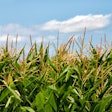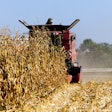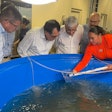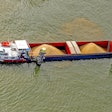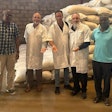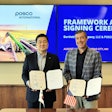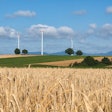
The U.S. feed and grain industries stand at a crossroads, facing a volatile mix of opportunities and challenges in 2025. From trade tensions and geopolitical instability to workforce concerns and unpredictable policy shifts, industry leaders are navigating uncharted waters as President Donald Trump’s second administration takes shape.
Trade: Disruption and opportunity
Trade remains a double-edged sword for the U.S. feed and grain industries. While new opportunities are emerging, concerns about tariffs and international agreements dominate the conversation. Mike Seyfert, president and CEO of the National Grain and Feed Association (NGFA), acknowledges the challenges but remains cautiously optimistic.
“While there will be challenges in some areas of trade, I believe there are also opportunities,” Seyfert said. “We might not be negotiating large free trade agreements, but there’s potential for deals involving specific commodities in different regions of the world.”
However, the outlook shifts sharply under a second Trump administration. Stephen Nicholson, executive vice president and global sector strategist for grains and oilseeds at RaboResearch, warns of disruptions driven by Trump’s hard-line trade tactics.
“Trump has thrown out a lot of bombs about trade,” Nicholson said, referring to proposed tariffs as high as 60% on China and 20% on other trading partners. “In my view, something bad is going to happen … there’s going to be disruption.”
Nicholson underscored the potential economic fallout, particularly for soybean producers. “If China decreased their U.S. soybean imports by 50%, we’re talking about prices dropping by $1.50 to $2 per bushel, down to the $8.50 range.” With Brazil now producing upwards of 120 million bushels annually, China’s reliance on U.S. soybeans has lessened, further complicating the trade landscape.
Constance Cullman, president and CEO of the American Feed Industry Association (AFIA), echoed similar concerns about tariffs, specifically the industry’s heavy reliance on China for critical inputs such as vitamins and amino acids.
“Eighty-five percent of vitamins and 60% of amino acids come from China,” Cullman said. “If there’s an interruption in that supply chain, it’s huge. And with tariffs reaching 60%, the implications are staggering.”
Workforce and immigration challenges
Another critical issue facing the agricultural sector is workforce availability. The U.S. feed and grain industries rely heavily on immigrant labor, particularly through programs like H-2A visas. Changes in immigration policies under a new administration could disrupt this workforce, creating significant bottlenecks.
“Agriculture needs that labor very badly,” said Nicholson, particularly referencing sectors like dairy and hog production. “If those people are deported, how do we get our food produced and to market?”
Seyfert emphasized the importance of maintaining legal immigration pathways.
“Our members hope that this focus on legal immigration will not negatively affect their workforce,” he said. While there is optimism that a stricter focus on legal entry could provide better workforce support, Seyfert admits questions remain.
Geopolitical uncertainty and supply chain vulnerabilities
Geopolitical instability is another unpredictable factor influencing the U.S. feed and grain markets. Cullman highlighted ongoing conflicts, including Russia’s invasion of Ukraine and rising tensions with China, as key concerns.
“We’re seeing more shipments out of Ukraine than people expected, but the war’s long-term impact on agriculture remains uncertain,” Cullman said.
She also pointed to growing U.S.-China tensions, emphasizing their impact on supply chains.
“It’s not just tariffs,” Cullman said. “China is being more aggressive, and we are seeing increasing economic interdependencies in areas like vitamins, amino acids and other critical inputs.”
Nicholson underscored China’s shifting dynamics, noting it is better prepared now than during the 2018-19 trade war.
“China has more stocks in place, and they’re pulling more soybean meal out of rations,” Nicholson said. “They don’t need us as much as they used to.”
In addition to China, Cullman identified North Korea’s strengthening ties with Russia as an underappreciated geopolitical wild card.
“North Korean troops are now being seen in Russia, which tells us two things: the toll on Russia is greater than Putin wants to admit, and North Korea is likely seeking advanced weapon technology in return.”
Shifts in domestic policy
The incoming administration’s domestic priorities are equally significant for the feed and grain industries. Cullman noted Trump’s focus on rolling back climate regulations, expanding U.S. energy production, and renegotiating the U.S.-Mexico-Canada Agreement (USMCA).
“Trump has said he wants to undo the Biden administration’s work on climate,” Cullman said. “We’ll likely see a withdrawal from the Paris Agreement and a rollback of international commitments.”
Energy production is another area of change and we’re likely to see a shift away from renewable fuels and a focus on energy dominance.
While the NGFA remains hopeful about advancing its priorities during the critical first two years of a new administration, Seyfert admitted the political climate will influence outcomes.
“A president’s first two years are always critical for advancing priorities,” he said. “We aim to make progress during this window while Congress is more likely to act.”
New players and opportunities
Despite the challenges, new opportunities are emerging. Nicholson pointed to rising demand in Southeast Asia and India as key markets for U.S. grain and feed exports.
“When you look longer term, Southeast Asia, including Vietnam and India, offers significant potential,” Nicholson said. “These are tough markets to navigate, but the opportunities are there.”
Nicholson also noted that Europe is becoming a bigger importer and predicted it will begin producing less crops, such as wheat and rapeseed, and begin importing more.
“There will big changes in Europe and that's going to be exacerbated by their climate change regulation," the European Union Deforestation Regulation, Nicholson said.
Adaptation is key
The U.S. feed and grain industries face an uncertain future shaped by geopolitical volatility, trade disruptions and domestic policy shifts. However, industry leaders emphasize the importance of adaptability, innovation and strategic planning to navigate these challenges.
“History will not repeat itself, but it’s certainly going to rhyme,” Nicholson said, reflecting on lessons from the past trade wars.
Cullman concluded with a call for proactive engagement.
“Our industry must stay engaged, advocate for sound policy and find solutions to mitigate risks," she said. "The road ahead will be challenging, but with the right strategies, we can seize the opportunities that lie ahead.”







